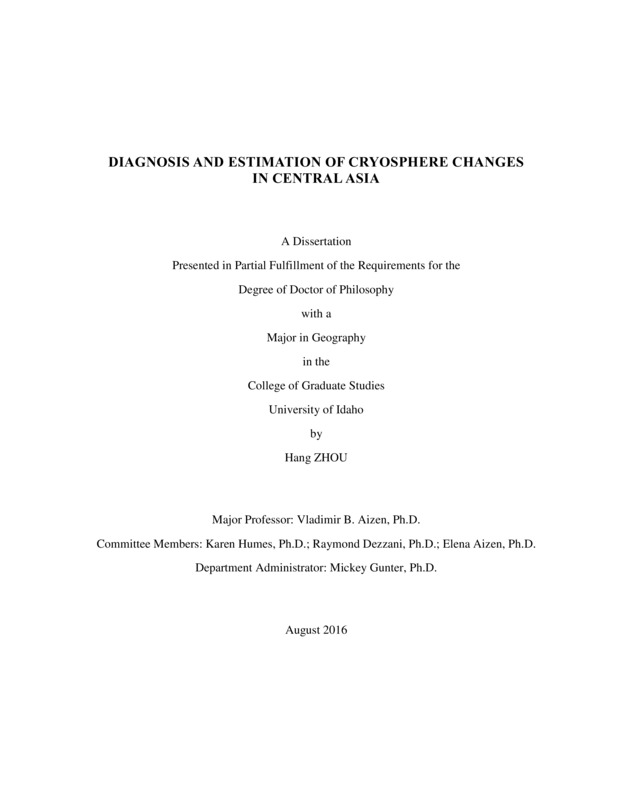DIAGNOSIS AND ESTIMATION OF CRYOSPHERE CHANGES IN CENTRAL ASIA
Zhou, Hang. (2016). DIAGNOSIS AND ESTIMATION OF CRYOSPHERE CHANGES IN CENTRAL ASIA. Theses and Dissertations Collection, University of Idaho Library Digital Collections. https://www.lib.uidaho.edu/digital/etd/items/zhou_idaho_0089e_10955.html
- Title:
- DIAGNOSIS AND ESTIMATION OF CRYOSPHERE CHANGES IN CENTRAL ASIA
- Author:
- Zhou, Hang
- Date:
- 2016
- Embargo Remove Date:
- 2018-07-29
- Keywords:
- central Asia climate cryosphere glacier remote sensing snow cover
- Program:
- Geography
- Subject Category:
- Geography
- Abstract:
-
This study aimed at quantifying the cryosphere changes in central Asia (CA) for the past ~20 to 40 years as consequences of regional climate changes using remote sensing and in-situ observation data.
A comprehensive climate dataset for CA was compiled from several sources. A gridded monthly climate dataset for 1951 - 2010 was created. CA experienced a climate regime change of increasing air temperature in 1976 / 1977. Stronger increase of air temperature happened in lower elevation and higher northern latitude. High elevation areas in Tien Shan and Pamir experienced a much smaller increase of temperature than other regions. Changes of precipitation vary across CA, with Pamir experienced increase of precipitation, mainly in winter, while decreases of precipitation occurred in the alpine regions of Tien Shan, especially in summer.
A series of long-term snow cover datasets at different temporal scales (daily / 8-day) and processing levels (original / gap-filled / adjusted) were developed from AVHRR and MODIS data. Statistics describing seasonal snow cover extent and timing in 1986 – 2008 have been calculated from AVHRR snow product. Long-term mean snow cover distribution, and effects of determining factors (elevation, latitude, and relative location to major mountains) were quantified. Trends of change of duration, onset date, and melt date of snow cover were analyzed using Theil-Sen regression. Decrease of snow duration was observed in mountains of Altai, Tien Shan and Pamir, and vast areas surrounding the Aral Sea, associated mainly with earlier melt date and significant increase of spring air temperature.
Databases of glacier extent and surface elevation were developed for two representative massifs, the Fedchenko Glacier Massif (FGM) and the Inylchek Glacier Massif (IGM). Both massifs experienced continuous glacier area loss in the period of 1975/1976 to 2000 and 2000 to 2007, with larger glaciers tend to experience less area loss, and stronger area loss rate in the latter period. The magnitude of glacier surface elevation lowering in the ablation zone in the IGM was much stronger than in the FGM, which can be attributed to the more favorable climate conditions for glaciers in the FGM.
- Description:
- doctoral, Ph.D., Geography -- University of Idaho - College of Graduate Studies, 2016
- Major Professor:
- Aizen, Vladimir B.
- Committee:
- Humes, Karen; Dezzani, Raymond; Aizen, Elena
- Defense Date:
- 2016
- Identifier:
- Zhou_idaho_0089E_10955
- Type:
- Text
- Format Original:
- Format:
- application/pdf
- Rights:
- In Copyright - Educational Use Permitted. For more information, please contact University of Idaho Library Special Collections and Archives Department at libspec@uidaho.edu.
- Standardized Rights:
- http://rightsstatements.org/vocab/InC-EDU/1.0/

